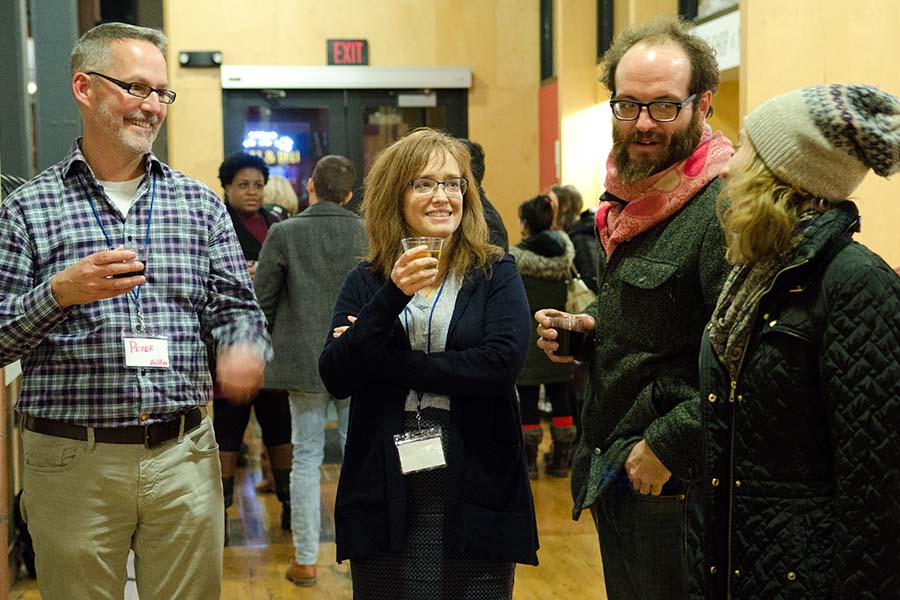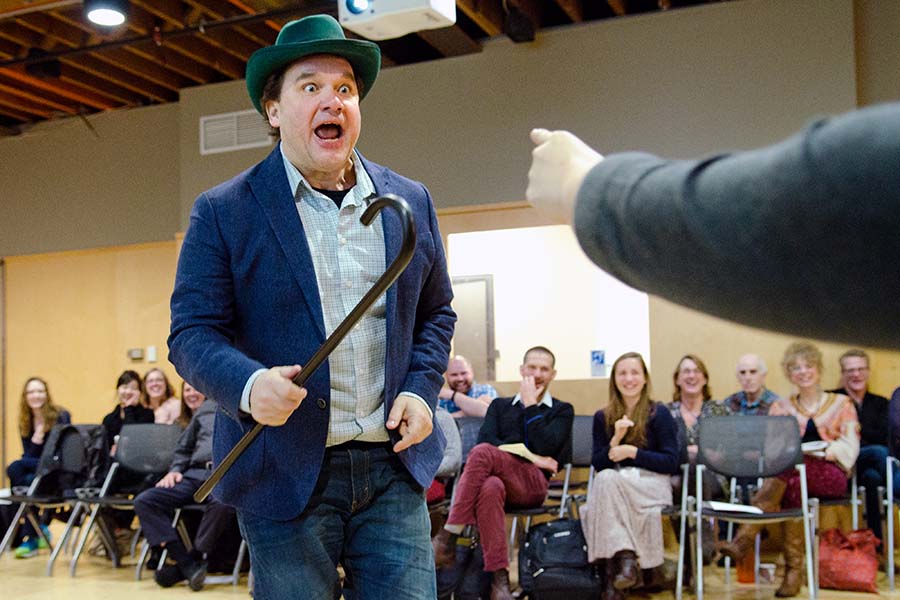“If I was going to spend my life making theatre, I didn’t want to make art for rich people.”
This is how Michelle Hensley, artistic director of Ten Thousand Things (TTT), a theatre company in Minneapolis, kicked off a recent conference held by TTT, Dec. 3-4 at Open Book. Supported by Theatre Communications Group’s Audience (R)Evolution program and the Doris Duke Charitable Foundation, the gathering drew around 100 theatremakers from across the country to compare notes about working with the grass-roots theatrical model championed by Hensley’s company. Its motto could be fairly summed up as: not art for rich people.
Or put another way: art for not-rich people. For 30 years Ten Thousand Things has been touring productions to prisons, transitional housing, rehab centers, immigrant centers, shelters for survivors of domestic violence, and more—and all for free.
“I didn’t want to leave anyone out,” Hensley told the assembled attendees. “I wanted to find an audience who cared about the story.” TTT productions are performed in the round, in whatever space their tour sites have available. The barrier between audience and artists—so marked in proscenium style—is gone. Actors mingle with audience members, interacting before, during, and after performances. The productions are spare: no lavish costumes, no fancy sets, no lights. Hensley puts a premium on story and language, knowing that if she and her artists do their job, everyone will come along for the ride, whether it’s a work by Shakespeare or Brecht, or a new play, or a classic musical. TTT also offers public performances of the same productions for paying attendees.
Because of the intimacy and immediacy of this approach, audiences often connect emotionally, and more deeply, than they do in proscenium theatres with the lights down. At the weekend gathering, many conference attendees shared stories to this effect, describing how one incarcerated woman in particular was moved by a wedding scene in The Tempest because she’d missed all the weddings in her family, or how audience members drove from Tijuana to San Diego just to see a bilingual Twelfth Night.
Conference attendees ranged from those who work at large theatres—the Old Globe in San Diego, the Public Theater in New York City—to bare-bones organizations and freelance directors exploring TTT’s model. Around 25 companies have reportedly expressed interest in adopting TTT’s model, and 10 are currently practicing some version of it.
The conference offered several breakout sessions, mostly for attendees to meet and share stories of their successes, challenges, and advice. (A large portion of the conference was livestreamed on HowlRound; the footage is here.) Questions raised in these sessions ranged from the practical exploration of production and touring costs and the use of sound to bigger questions of whether or not the model can work with new plays and musicals.
Playwright Kira Obolensky led a session on choosing material that would work in the intimate settings pioneered by TTT. She began by posing a question the company asked her when she applied to be their playwright-in-residence (and got the gig): What story would you tell if everyone was in the audience? “This question changed me as a playwright and as a human,” she said. “I don’t think a lot of American playwrights and directors ask themselves this question.” This opened up a discussion among those assembled about theatremakers’ assumptions about the audiences they serve (and don’t serve).

Daniel Bryant from Center Stage in Baltimore told the session attendees that his first production with the TTT model was Samuel Beckett’s Endgame. He said that some doubted whether men in a recovery home would be able to understand the play, but Bryant trusted his intuition and it paid off: Audiences loved it. One man in the recovery home related to the husband in the trash can, seeing a parallel to his time as an addict and his swinging between stinginess and generosity. On a similar note, other session attendees said they had assumed they’d be introducing their audiences to theatre for the first time, which often turned out not to be true.
Obolensky encouraged attendees to look for plays that were “stretchy,” meaning material that could adapt to the intimate model and to different audiences. So many contemporary plays, she pointed out, are written about and for middle- to upper-class white families. Theatremakers should instead seek out plays that offer “imaginative distance”—that take place in another time or world, with characters are a little more archetypal, and ask big questions. Most importantly: The plays shouldn’t be condescending or preachy. TTT doesn’t perform for the incarcerated or for recovering addicts to give them a message; they just want to share good stories.
To be sure, those “good stories” have very often been plays by Shakespeare, Tennessee Williams, the ancient Greeks, and other “dead white guys,” as the attendees put it. Freelance director Rebecca Novick told the group that she got some pushback along these lines when she began working with the TTT model with California Shakespeare Theatre. While older works do often provide that imaginative distance, as well as opportunities for color-conscious casting, they don’t specifically represent women or people of color. Certainly the name recognition of canonical writers helps spark conversations, and “old plays are good for making us see our lives are kind of the same,” Obolensky pointed out. But Obolensky also urged the session attendees to find playwrights in their own communities to write new plays that would work in the TTT format.
Brad Delzer reported that he recently began employing TTT’s model with True North Theatre, his new theatre company in Carlisle, Pa. Sensing an opportunity to bring theatre to places that don’t typically see it, and to connect with the strong military community in the Carlisle area, Dezler toured Lisa Peterson and Denis O’Hare’s An Iliad to a soup kitchen, a men’s shelter, and the town’s Army Heritage Center, before holding two public performances.
“It went a lot better than I thought it would,” Delzer said. He had been generally apprehensive about the whole thing, but had particularly fretted about how a six-minute list of wars from the last few centuries would go over. “It played really well,” he said, noting the power that came from the moment. “It surprised us.”
Delzer acknowledged that his choice of play didn’t do much to challenge the “dead white guy” domination plaguing much of the theatre world, and he aims to correct that in the future. On the flip side, freelance director Chari Arespacochaga is deploying the TTT model specifically to challenge Western theatre traditions and plays by predominantly white voices. “I’m looking for models for doing new pieces,” she said. Though she works in both New York and L.A., Arespacochaga wants to see theatre get more decentralized and invite in more stories. She’s currently working on musical theatre pieces for young audiences based on books in the Guardian Princesses series (“There’s no Prince Charming,” she explained of the series). Her latest project focuses on Princess Ten Ten, a gender-non-conforming princess who uses their prowess in martial arts to bring together their people and clear the skies of pollution.
New plays, devised works, certain contemporary plays: All can work in the TTT model. Musicals, too. For the opening session of the second day of the conference, Hensley and TTT’s musician/music director Peter Vitale described some of the musicals they’ve staged, then performed several numbers: “Matchmaker,” “76 Trombones” (with just seven people!), “Somebody, Somewhere,” and “‘Till There Was You.” Hensley and Vitale stressed the importance of choosing musicals with strong books and keeping the focus on the story. “For me, it’s all about the acting,” Hensley said. “In this intimate space, you don’t need a big, booming Broadway voice.” To that end, TTT doesn’t always cast artists who might be considered the best singers, instead favoring the best actors for the roles and for the production.
And because the actors are accompanied musically only by Vitale, there’s room to let the songs breathe. TTT’s “Matchmaker,” for instance, didn’t have the usual driving tempo, instead inserting pauses where appropriate, bracketing certain moments to highlight just how scary arranged marriage can be. Hensley pointed out that TTT often performs in immigrant centers where attendees have experienced an arranged marriage, and they wanted to honor that reality.

Relatedly, Vitale led a workshop on using sound in plays to support scene changes and action, since the TTT model by design can’t use lighting changes. Vitale uses an old keyboard and various percussion instruments to underscore and provide transitions: urgent drums for the entrance of a messenger, eerie bowed brass discs for death scenes, a gong for important figures, recorded sounds from the keyboard for otherworldly characters.
He emphasized that these instruments are simply what has worked for TTT, especially because many prisons and other facilities don’t allow laptops or other electronics on the premises. Other theatres and practitioners might find different combinations of instruments that work for them. After an attendee asked what Vitale would recommend in a starter kit, he suggested a gong, chimes, bass drum, snare drum, and a keyboard. None of the instruments should be high quality, he said, since you cart them around so much, and you can get the same effect with a $45 gong as you would with a more expensive one.
But how to fund and produce a tour that offers free performances and demands quality artists? Conference attendees came from theatres across the full spectrum of budgets—$20 million down to a few thousand dollars. During a session expressly about how to pay for the TTT model, attendees shared insights into ticket pricing, reaching out to donors, and making strategic partnerships. Partnerships are valuable for several reasons: Not only can theatre companies share resources, but there are cases when a larger company may be able to apply for grants a smaller one cannot, and the grant support would help both companies, so it’s a win-win. Partnerships also allow theatre companies to reach new audiences as well as potential new donors, ultimately spreading the value and joy of the work.
Throughout the weekend, conference attendees shared story upon story about tours they’ve organized, audiences they’ve met, plays they’ve performed. What everyone kept coming back to was the idea of generosity. The TTT artists on hand during the conference spoke to the regenerative nature of their work with the company. With the TTT model, artists and audience are in the play together, giving each other energy, going on the journey of the story together at the same time. As Freedome Bradley-Ballantine, from the Old Globe, said during one session, “Most people who got into theatre wanted to make change.” When you make theatre will all of the lights on, you can see that change happen before your eyes.


